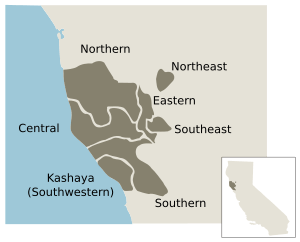Kashaya language facts for kids
Quick facts for kids Kashaya |
||||
|---|---|---|---|---|
| Kʼahšá:ya | ||||
| Native to | United States | |||
| Region | Sonoma County, California | |||
| Ethnicity | Kashia | |||
| Native speakers | 24 (2007) | |||
| Language family |
Hokan?
|
|||

The seven Pomoan languages with an indication of their pre-contact distribution within California
|
||||
|
||||
Kashaya (also known as Southwestern Pomo or Kashia) is a special language spoken by the Kashia people. It is a language that very few people speak today, making it critically endangered. The name Kashaya means "skillful" or "expert gambler" in nearby languages. It is part of the Pomoan languages family. Some experts believe it is also connected to a larger group of languages called Hokan.
Contents
What is Kashaya Language Like?
Kashaya is a fascinating language with unique sounds and word structures. It helps us understand the rich history and culture of the Kashia people.
How Kashaya Sounds: Vowels and Consonants
Every language has its own set of sounds. Kashaya has five main vowel sounds. Each of these can be short or long. A long vowel is shown with a raised dot (ꞏ) in writing. For example, ʔihya means "bone," but ʔihya: means "wind." This shows how important vowel length is!
Kashaya also has many consonant sounds. Some of these sounds are made in different parts of the mouth. For instance, there are two "t" sounds. One is made with the tongue touching the teeth, and the other with the tongue touching the ridge behind the teeth.
Vowel Sounds in Kashaya
| Short Sounds | Long Sounds | |||
|---|---|---|---|---|
| Front | Back | Front | Back | |
| High (close) | i | u | iː | uː |
| Mid | e | o | eː | oː |
| Low (open) | a | aː | ||
Consonant Sounds in Kashaya
Kashaya has many different consonant sounds. Some are made by stopping the air, like 'p' or 'k'. Others are made by letting air flow, like 's' or 'h'. Some sounds are "ejective," meaning they are made with a burst of air. Others are "aspirated," meaning they have a puff of air after them.
| Lips | Teeth | Alveolar | Palate | Velar | Uvular | Throat | ||
|---|---|---|---|---|---|---|---|---|
| Stops | plain | p | t | ṭ | c | k | q | ʔ |
| aspirated | pʰ | tʰ | ṭʰ | cʰ | kʰ | qʰ | ||
| ejective | pʼ | tʼ | ṭʼ | cʼ | kʼ | qʼ | ||
| voiced | b | d | ||||||
| Fricatives | voiceless | (f) | s | š | h | |||
| ejective | sʼ | |||||||
| Nasal | plain | m | n | |||||
| aspirated | mʰ | nʰ | ||||||
| glottalized | mʼ | nʼ | ||||||
| Approximant | plain | w | l (r) | y | ||||
| aspirated | wʰ | lʰ (rʰ) | yʰ | |||||
| glottalized | wʼ | lʼ (rʼ) | ||||||
How Words are Built: Syllables and Stress
In Kashaya, most words are built with simple syllables. A syllable usually starts with one consonant and then has a vowel. It can also end with one consonant. For example, duwi means "coyote."
Sometimes, words borrowed from other languages like Spanish or Russian can have more complex syllables. The way you say a word, especially which part you emphasize (called "stress"), can change its meaning. This stress can move around in a word, making Kashaya pronunciation quite tricky!
For example, the word momácʰmela means "I ran in." The stress helps you know how to say it correctly.
Sound Changes in Kashaya
Sounds in Kashaya can change depending on where they are in a word or next to other sounds. This is called a "phonological process."
- For example, a sound like nʼ can change to d when it's at the beginning of a syllable. So, canʼpʰi means "if he sees," but cadu means "look!"
- Vowels can also change. The vowel i might become a after an m sound, or u after a d sound.
- Sometimes, a sound like q at the end of a syllable might lose its exact place of articulation. This means it becomes a softer sound.
How Kashaya Words are Formed: Morphology
Kashaya is a polysynthetic language. This means words can be very long and have many parts, like building blocks. Most of these parts are added to the end of a word (suffixes), but some are added to the beginning (prefixes).
Nouns: Naming Things
Nouns are words for people, places, or things. In Kashaya, nouns don't change much. But words for family members, like "grandmother," can have prefixes that show who owns them. For example, miqasʼ means "your grandmother."
Verbs: Describing Actions
Verbs are action words. Kashaya verbs are very complex! They can have many suffixes added to them. These suffixes tell you lots of information, like when the action happened, how it happened, or who did it.
Instrumental Prefixes
One special thing about Kashaya verbs is their "instrumental prefixes." These are small parts added to the beginning of a verb. They tell you how an action was done. There are about 20 of these prefixes!
- ba- means "with lips or snout."
- da- means "with the hand."
- du- means "with the finger."
- si- means "by water."
For example, the root hcʰa means "knock over."
- ba-hcʰa- means "knock over with snout."
- da-hcʰa- means "push over with the hand."
Verb Suffixes
Kashaya verbs also have many suffixes. These are added to the end of the verb root. They can show:
- Direction: Like -ad for "along" or -ala for "down."
- Cause: Like -hqa meaning "to cause something."
- Duration: Like -ad meaning "for a long time."
- Evidence: These suffixes tell you how the speaker knows something. For example, -do means "it's said that," and -ya means "I saw it."
The very last suffix on a verb is super important. It tells you if the verb is a command, a future action, or something else.
Here are some examples of long Kashaya verbs:
- pʰa-ʔdi-c-á꞉d-ala-w means "to poke with the end of a stick while moving downhill."
- nohpʰo-yíʔ-ciʔ-do means "it's said that those former people used to live (like that)."
How Sentences are Built: Syntax
The way words are put together to make sentences is called syntax. In Kashaya, the order of words in a sentence can be quite flexible. However, the verb usually comes at the end of the sentence.
For example, to say "I see that dog," you could say:
- hayu mul ʔa canʼ (dog that I see)
- hayu ʔa mul canʼ (dog I that see)
Younger speakers sometimes use a word order more like English (Subject-Verb-Object).
Case Marking: Who Does What
Kashaya uses "case markers" to show the role of a noun in a sentence. This helps you know who is doing the action and who the action is happening to.
- The subjective case (like ʔem) shows who is doing the action.
- The objective case (like ʔel) shows who the action is happening to.
For example:
- ʔacacʼ em ʔima꞉ta ʔél cadu means "the man (ʔacac) sees the woman (ʔima꞉ta)."
Pronouns (like "I," "you," "he") also have different forms for subjective and objective cases.
Pronouns in Kashaya
| One Person | Many People | ||||
|---|---|---|---|---|---|
| Who is doing it | Who it happens to | Who is doing it | Who it happens to | ||
| 1st person (I, We) | ʔa(:) | to(:) | ya | yal | |
| 2nd person (You) | ma | mito | maya | mayal | |
| 3rd person (He, She, They) | male | mu꞉kinʼ | mu꞉kito, mu꞉bal | ma꞉cac | ma꞉cal |
| female | manʼ | ma꞉dal | |||
| Reflexive (Myself, Yourself) | ti(꞉) | tito | same as singular | ||
Demonstrative words (like "this" or "that") also change depending on their role in the sentence.
Notable Kashaya Pomo Speakers
Many people have worked to keep the Kashaya language alive.
- Essie Pinola Parrish (1902–1979) was a famous basket weaver. She taught Kashaya children their language. She also helped create a Kashaya Pomo dictionary with a scholar named Robert Oswalt.
- Langford "Lanny" Roger Pinola (1938–2003) was another important Kashaya speaker. He lived on the Kashaya Reservation when he was young.


